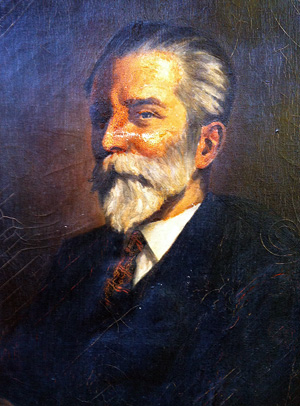Maurice Hébert (1861-1933)
 Maurice Auguste Hébert
was born in Bourgoin (Isère), France, on July 7, 1861. At age twenty he
left France for New Orleans, working shipboard as a cook. Though artistic and
the cousin of the great French artist Ernest Hébert (1817-1908), Maurice
Hébert started his new life in this country serving in the militia and
singing in the chorus of the opera in New Orleans. He later worked in Santa Fe,
New Mexico, as a merchant.
Maurice Auguste Hébert
was born in Bourgoin (Isère), France, on July 7, 1861. At age twenty he
left France for New Orleans, working shipboard as a cook. Though artistic and
the cousin of the great French artist Ernest Hébert (1817-1908), Maurice
Hébert started his new life in this country serving in the militia and
singing in the chorus of the opera in New Orleans. He later worked in Santa Fe,
New Mexico, as a merchant.
During the 1890s Hébert moved to Chicago, where he commenced work as an architect and a decorator. He completed courses in architecture through the International Correspondence School sometime after 1895. In 1900 he set up practice in New York City, with branch offices in Paris, Lyon, and Grenoble. His first major project was a French Chateau style mansion on Riverside Drive for Bethlehem Steel magnate Charles M. Schwab. It was completed between 1901 and 1905.
While the Schwab Mansion was under construction, Hébert was retained by Fresno land baron M. Theo. Kearney to design a country home for his Fruitvale Estate. The home was to be patterned after the Chateau at Chenonceaux, France. As early as 1888, Kearney had retained San Francisco artists Moretti and Trezzini to produce a conceptual rendering of this proposed home. Several architects, including Pissis & Moore and Wright & Polk of San Francisco, worked on the commission before Hébert took over in 1903. Upon Kearney's death in 1906, however, the University of California inherited the Fruitvale Estate and halted the project, which was under construction at the time.
In 1907 Hébert opened an office with Francis X. Lourdou in Los Angeles. Hébert & Lourdou's major project there was a residential villa, since destroyed, for L. N. Brunswig. Hébert returned to Chicago in 1909, later designing a line of period-style phonograph cabinets for the New Majestic Phonograph Company. In 1919 he worked as a designer for American Renaissance Inc., a builder of prefabricated homes in Milwaukee, Wisconsin.
At the time of his death in 1933, Maurice Hébert was involved as a designer on the Century of Progress International Exposition at Chicago.
©2003 John Edward Powell. All rights reserved. Portrait of Maurice Hébert courtesy of Trevor Hébert.